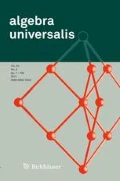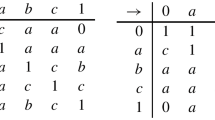Abstract
Motivated by the classical work of Halmos on functional monadic Boolean algebras, we derive three basic sup-semilattice constructions, among other things, the so-called powersets and powerset operators. Such constructions are extremely useful and can be found in almost all branches of modern mathematics, including algebra, logic, and topology. Our three constructions give rise to four covariant and two contravariant functors and constitute three adjoint situations we illustrate in simple examples.

Similar content being viewed by others
Data Availability
Data sharing does not apply to this article as no datasets were generated or analysed during the current study.
References
Adámek, J., Herrlich, H., Strecker, G.E.: Abstract and Concrete Categories: The Joy of Cats. John Wiley and Sons, New York (1990)
Banaschewski, B.: Another look at the Localic Tychonoff Theorem. Comment. Math. Univ. Carolinae 29, 647–656 (1988)
Chajda, I., Paseka, J.: Algebraic Approach to Tense Operators. Heldermann Verlag, Lemgo (2015)
De Mitri, C., Guido, C.: Some remarks on fuzzy powerset operators. Fuzzy Sets Syst. 126, 241–251 (2002)
Gerla, G., Scarpati, L.: Extension principles for fuzzy set theory. J. Inform. Sci. 106, 49–69 (1998)
Halmos, P.: Algebraic logic I: monadic Boolean algebras. Compos. Math. 12, 217–249 (1955)
Halmos, P.: Algebraic Logic. Chelsea Publishing Company, New York (1962)
Joyal, A., Tierney, M.: An extension of the Galois theory of Grothendieck. Am. Math. Soc. Memoirs No. 309 (1984)
Kruml, D., Paseka, J.: Algebraic and categorical aspects of quantales. In: Hazewinkel, M. (ed.) Handbook of Algebra, vol. 5, pp. 323–362. Elsevier, Amsterdam (2008)
Nguyen, H.T.: A note on the extension principle for Fuzzy sets. J. Math. Anal. Appl. 64, 369–380 (1978)
Priestley, H.A.: Representation of distributive lattices by means of ordered Stone spaces. Bull. Lond. Math. Soc. 2, 186–190 (1970)
Prior, A.N.: Time and Modality. Clarendon Press, Oxford (1957)
Rodabaugh, S.E.: Powerset operator foundations for poslat fuzzy set theories and topologies. In: Höhle, U., Rodabaugh, S.E. (eds.) Mathematics of Fuzzy Sets: Logic, Topology, and Measure Theory, pp. 90–116. Kluwer Academic Publisher, Boston (1999)
Solovyov, S.A.: Powerset operator foundations for catalg fuzzy set theories. Iran. J. Fuzzy Syst. 8, 1–46 (2001)
Stone, M.H.: The theory of representations for Boolean algebras. Trans. Am. Math. Soc. 40, 37–111 (1936)
Stone, M.H.: Topological representations of distributive lattices and Brouwerian logics. Čas. Mat. Fys. 67, 1–25 (1937)
Yager, R.R.: A characterization of the extension principle. Fuzzy Sets Syst. 18, 205–217 (1996)
Zadeh, L.A.: Fuzzy sets. Inf. Control 8, 338–353 (1965)
Zhang, X., Laan, V.: Injective hulls for ordered algebras. Algebra Univers. 76, 339–349 (2016)
Acknowledgements
We thank the anonymous referee for the thorough reading and contributions to improve our paper presentation.
Author information
Authors and Affiliations
Corresponding author
Additional information
Presented by M. Plošica.
Publisher's Note
Springer Nature remains neutral with regard to jurisdictional claims in published maps and institutional affiliations.
The research of the first author was supported by the IGA under grant no. PřF 2021 030. The second author acknowledges the support by the Austrian Science Fund (FWF): project I 4579-N and the Czech Science Foundation (GAČR): project 20-09869L, entitled “The many facets of orthomodularity”. Support of the research of the third author by the project “New approaches to aggregation operators in analysis and processing of data”, Nr. 18-06915S by Czech Grant Agency (GAČR) is gratefully acknowledged.
Rights and permissions
Springer Nature or its licensor holds exclusive rights to this article under a publishing agreement with the author(s) or other rightsholder(s); author self-archiving of the accepted manuscript version of this article is solely governed by the terms of such publishing agreement and applicable law.
About this article
Cite this article
Botur, M., Paseka, J. & Smolka, R. Another look on tense and related operators. Algebra Univers. 83, 41 (2022). https://doi.org/10.1007/s00012-022-00794-1
Received:
Accepted:
Published:
DOI: https://doi.org/10.1007/s00012-022-00794-1




